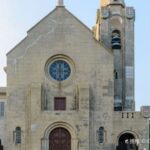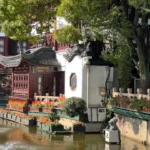St. Augustine’s Church in Macau was built by the Italian Catholic Augustinian Order when they came to Macau to preach in 1586. Three years later, it belonged to the Portuguese. It is the first church in Macau to preach in English. The church was renovated in 1825. It has a magnificent and majestic appearance. The interior decoration is spacious and large. There is a statue of Jesus carrying the cross on the altar made of marble. The front wall of the church is divided into two layers, and there is a triangular gable on the top. Two ancient Greek granite columns are placed on both sides of the main entrance. The main columns inside divide the church into three sections and support its arched roof.
There are many legends about St. Augustine’s Church. It is said that when the statue was taken to the cathedral by church officials, it would miraculously return to the altar of St. Augustine’s Church. Therefore, the statue is still placed in its original position. In the 16th century, when Western missionaries began to preach in Macau, they built several churches. In the eyes of the Chinese at that time, religious buildings were called ‘temples’. St. Augustine’s Church in Senado Square was very simple when it was first built. Whenever it rained, the priests covered the roof with palm leaves to shelter from the wind and rain. The flying leaves reminded the Chinese of the fluttering dragon whiskers, so the church was called ‘Dragon Whisker Temple’. Later, it was also called ‘Dragon Pine Temple’ or ‘Dragon Duke Temple’ in Cantonese pronunciation. Therefore, the street beside the church is called Dragon Pine Street. From the ‘temple’ at that time to the ‘church’ later, it reflects the integration of Chinese and Western cultures in Macau, and it is everywhere. After Macau was opened as a port, Western missionaries took Macau as the first stronghold to enter China to spread the gospel. Therefore, Macau is called ‘the city of holy names’. The missionaries living in Macau come from countries such as Portugal, Spain, and Italy. The masses they hold are mostly in Portuguese or English. They also preach in Cantonese according to the residents of Macau. St. Augustine’s Church is the first church to preach in English. Since the establishment of the Macau diocese in the 16th century, Macau has been inheriting this tradition – the procession of the statue of the suffering Jesus on February 12th – February 13th. The procession lasts for two days. On the first day, the solemn statue of the suffering Jesus carrying the cross departs from St. Augustine’s Church on the hilltop and is welcomed to the cathedral. The statue remains in the cathedral to receive blessings. On the second day, the statue of the suffering Jesus is carried out for a tour by the priests and then returned to St. Augustine’s Church. The procession of the statue of the suffering Jesus is one of the important festival activities of the Catholic Church in Macau. Opening hours: Open all year round from 10:00 to 18:00. Must-see tips and travel guides: The church is opposite the Dom Pedro V Theatre and next to the Sir Robert Ho Tung Library. It is a European-style building decorated in Baroque style. The interior structure of the church is similar to that of St. Dominic’s Church. The space is divided into two by two rows of columns.On the second to last day of December, a ceremony is being held in the church. Photography is not allowed.









